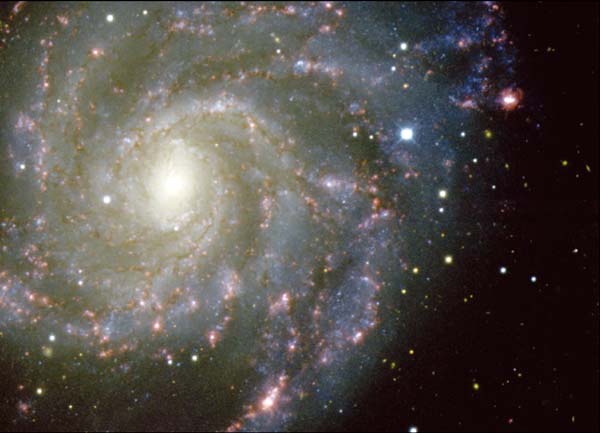Astronomers have put under scrutiny the brightest and closest stellar explosion seen in the past 25 years. They have identified the supernova in the Pinwheel galaxy observed on 24 August 2011 as the explosion of a carbon-oxygen white-dwarf star triggered by mass accretion, most likely from a normal companion star.

The supernova SN 2011fe is clearly visible as the bright, bluish star in the upper, right portion of this image of M101 obtained with the Mayall 4-m telescope at Kitt Peak National Observatory.
Image credit: T A Rector (University of Alaska Anchorage), H Schweiker & S Pakzad NOAO/AURA/NSF.
Although a supernova – Latin for “super-new” – appears suddenly in the sky as a bright star, it is well known that the event marks the explosive demise of a star rather than its birth. Supernovae are rare, with a rate in the Milky Way of only about two per century (CERN Courier January/February 2006 p10). The majority of these stellar explosions (around 80%) are core-collapse supernovae, which result from the gravitational contraction of the central iron core of a star of more than about 10 solar masses that can no longer sustain nuclear fusion. While the core collapses into a neutron star or a black hole, the outer regions of the star are blown up in a gigantic explosion. Supernovae of type Ia are different. They are thought to be thermonuclear explosions of a white dwarf that result in complete disruption and leave no compact remnant. The historic supernovae of the years AD185, 1006, 1572 and 1604 have been identified to be of this type (CERN Courier December 2004 p15, CERN CourierMay 2011 p12, CERN CourierDecember 2011 p12).
The event, PTF11kly, detected on 24 August 2011 in the nearby Pinwheel galaxy (Messier 101) was also soon identified as a type Ia supernova (CERN Courier October 2011 p12). Although the explosion was invisible to the unaided eye, it was bright enough (peak magnitude of 9.9) to trigger the interest of professional and amateur astronomers alike. The early detection of SN 2011fe, as it is called now, and its optimal location in a face-on spiral galaxy some 20 million light-years away, offered a rare chance for a better understanding of the progenitors of type Ia supernovae. The results of these investigations have now been published in two papers in Nature.
The first study, led by Peter Nugent of the Lawrence Berkeley National Laboratory and the University of California, is based on the early observations of SN 2011fe. It was detected only 0.5 days after ignition and the luminosity at that time allowed the researchers to constrain the size of the progenitor star to be less than one tenth that of the Sun. This is strong evidence that the exploding star was a white dwarf. These dense stars contain the mass of the Sun within a size similar to the Earth and are the remnant cores of low-mass stars. Usually composed of carbon and oxygen, they maintain their structure via internal pressure from a degenerate gas of electrons. The star remains inert and stable as long as its mass does not reach the Chandrasekhar limit of 1.4 solar masses. When approaching this critical mass – for instance via accretion from a companion star – a runaway nuclear fusion of carbon ignites within the white dwarf and provokes the stellar explosion. The detection of the presence of carbon and for the first time also of oxygen in the spectrum of SN 2011fe confirms this scenario.
As for the nature of the companion star, there were basically three possibilities: a normal star; a much brighter red giant or helium star; or another white dwarf. Nugent and co-workers suggest a normal star based on the absence of the expected observational imprint that a white-dwarf merger of a giant star would leave. This is confirmed by the second study by Nugent’s colleague of the University of California, Weidong Li and collaborators. They find no bright source at the position of SN 2011fe in archival images, thus ruling out luminous red giants and almost all helium stars as the mass-donor. The two studies confirm observationally the origin of type Ia supernova, a class of explosion that are similar enough to each other to be considered “standard candles” – a property that enabled the 2011 Nobel prize winners to discover the accelerating expansion of the universe (CERN Courier September 2003 p23).







